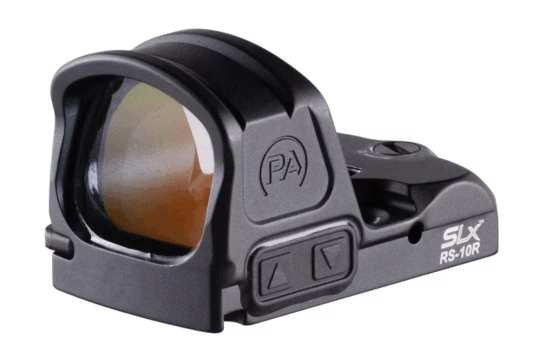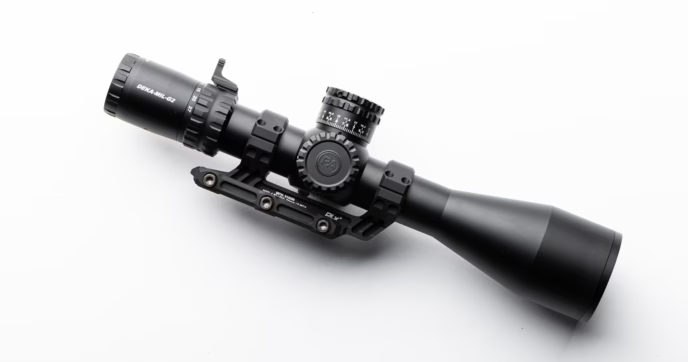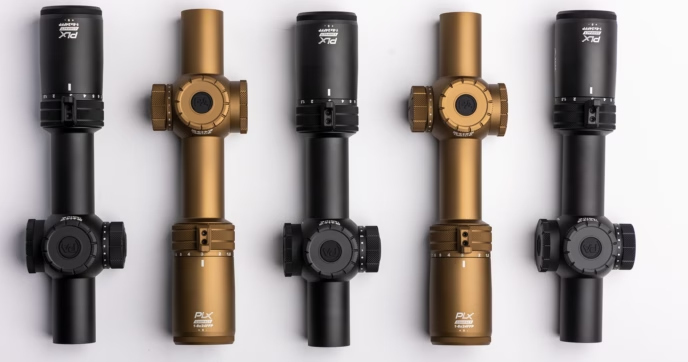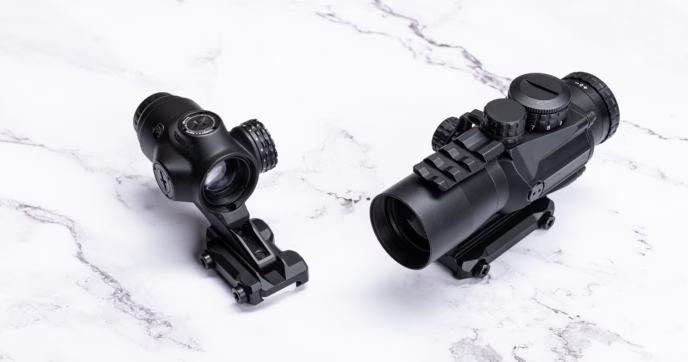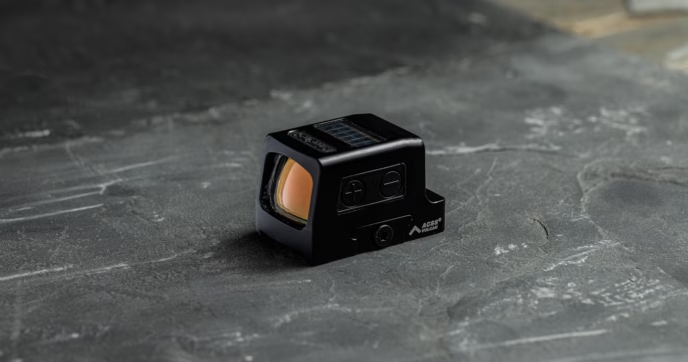In our previous installments of Behind the Glass, we’ve focused primarily on rifle optics, highlighting the intricate designs and overall adaptability of prism scopes and LPVOs. And while we highly recommend giving them a read before you start kitting out your rifle, we can’t stress how crucial a role handguns play in having a well-rounded loadout, whether it be for competitive, duty, recreational training, or personal defense.
Out of the box, handguns come equipped with all of the basic components needed to be usable, but this doesn’t mean that they can’t be improved. Most, if not all of the handguns offered today are designed to house one of the greatest game changers in modern sidearms: mini-reflex and pistol red dot sights.
Pistol optics are easily one of the best upgrades you can make to your handgun. They offer an insurmountable number of advantages over traditional iron sights, but just like the other optics we’ve discussed thus far, there’s a lot to choose from, with there being several excellent picks in Primary Arms Optic’s lineup.
Welcome to Behind the Glass Part Three! In this one, we’ll be focusing on the unique designs and features of PAO’s mini-reflex sights.

What is a Mini Reflex Sight?
For the uninitiated, mini-reflex sights are a type of smaller reflex sight designed for use on handguns, though they can be used on other platforms as well. These optics are typically found in one of two categories: open-emitter mini reflex sights and enclosed-emitter pistol red dot sights. Both optics are a solid pick for handguns of all sizes, but their respective designs give them their own distinct advantages to consider.
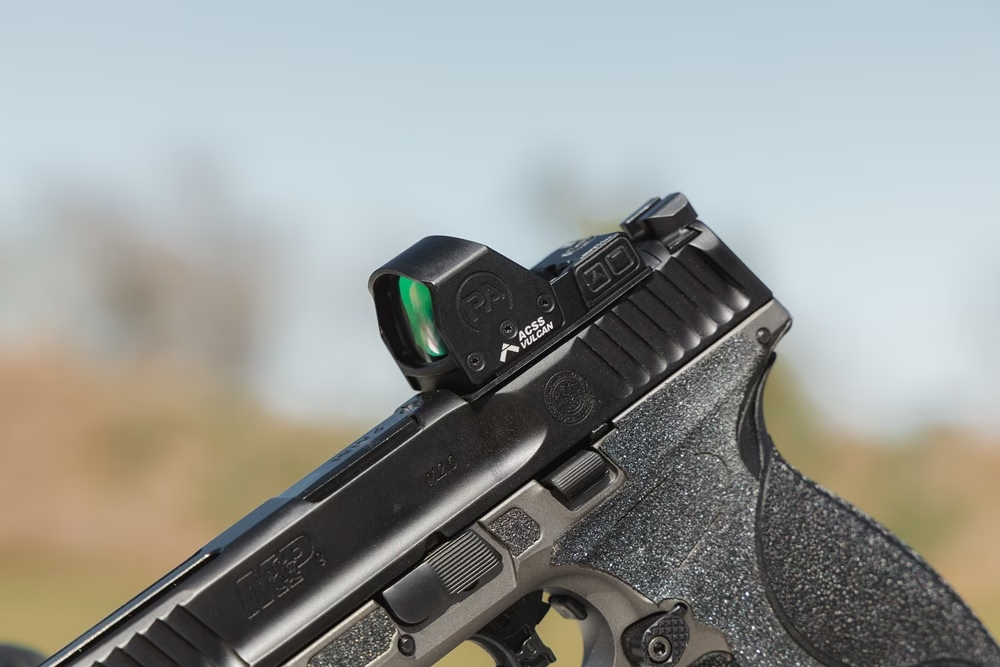
Open-Emitter Mini-Reflex Sights
Much as their name would suggest, open-emitter mini-reflex sights make use of an open design, meaning they only have one lens, and an exposed emitter diode. The open design of these optics gives them an incredibly wide field of view (FOV), allowing you to get a full picture of your target without constricting much of your peripheral vision. While this allows you to place your full focus on the target, it’s important to recognize that this comes at the cost of having an exposed emitter diode.
For most enthusiasts, this isn’t that big of an issue. However, if you plan on using your handgun in a more intensive training, competitive, or duty environment that’s rife with environmental hazards like water, dirt, mud, and other debris, the diode could become occluded, preventing it from projecting the reticle. This isn’t to say that these optics aren’t suitable for these applications; it’s just something to be mindful of.
Also, since there isn’t an enclosure to accommodate, the lenses of open emitter optics can be much larger without having to increase the overall footprint and weight of the optic by much. As such, they’re a solid pick for just about every application, though you will need to be a bit more mindful of emitter diode when using your pistol in harsher conditions.

Enclosed-Emitter Pistol Red Dot Sights
Enclosed-emitter pistol red dot sights function nearly identically to their open-emitter counterparts, but their primary difference lies in the way they’re constructed. Pistol red dot sights are, in essence, a smaller version of full-size red dots that are designed for rifles. As such, they have a completely enclosed design and two lenses, keeping the emitter diode fully sealed against the elements and any other environmental factors.
Pistol red dots make use of incredibly rigid optic bodies, making them strong enough to face everything from recreational range trips to the demands of professional use in harsh conditions. This added durability does, however, come at the cost of added weight and a narrower FOV. Although the difference isn’t necessarily all that drastic, enclosed optics have more material in their construction, so they typically weigh around 3 to 5 ounces more than open-emitter optics. And, since the optic body is enclosed, they have a narrower, more constricted FOV, comparatively.
Again, just like with open-emitter optics, this isn’t to say that they aren’t usable by any means. It’s just that their added durability comes with this slight trade-off. With that in mind, as long as you train regularly and become familiar with the handling of your optic, enclosed pistol red dot sights can be a practical pick for every application.
Is one better than the other?
Not necessarily. Like we said, each optic offers its own unique set of advantages. What open-emitter optics lack in overall durability, they make up for in target acquisition speed and FOV. And what pistol red dots lack in terms of FOV, they make up for in sheer durability. At the end of the day, choosing one is a matter of deciding which one is best for your needs and setup.
Also, we hinted at this earlier, but mini-reflex sights aren’t only compatible with pistols. Enthusiasts running smaller rifle setups, such as PCCs and PDW-style rifles, often opt for mini-reflex sights because of their smaller footprint and light weight. And with PAO optics, assuming you have the right Primary Arms Red Dot Mounts for your optic, you can effectively run your mini-reflex sight on just about any firearm
Why Choose a Primary Arms Mini-Reflex Sight?
If you’ve already read our previous Behind the Glass entries, you’ll know that Primary Arms Optics really does offer something for every enthusiast. Each of Primary Arms’ Red Dot Sights are meticulously crafted to be as reliable and have as many features as possible. And no matter your budget and intended use, they have optics that cater to everyone’s needs.
As far as mini-reflex sights are concerned, PAO offers options in each of their optic tiers—those being their Classic Series, SLx®, GLx®, and PLx® optic lines. We go over each one in our guide on PAO Optic Tiers, but for simplicity’s sake, each optic tier is, in the order listed above, an incremental increase in quality and price. We recommend giving the Optic Tier guide a read to get a fuller understanding of what each one offers, but without further ado, let’s get into what each tier has to offer.
Classic Series Reflex Sights: Trusted, Affordable, and Simple
If you’re in the market for a pistol dot that doesn’t break the bank but doesn’t compromise on quality, PAO’s Classic Series reflex sights are where it’s at. Of their offerings, Primary Arm’s Classic red dot options are some of the most affordable ones on the market, and as mentioned above, they’re backed by PAO’s commitment to crafting high-quality optics.
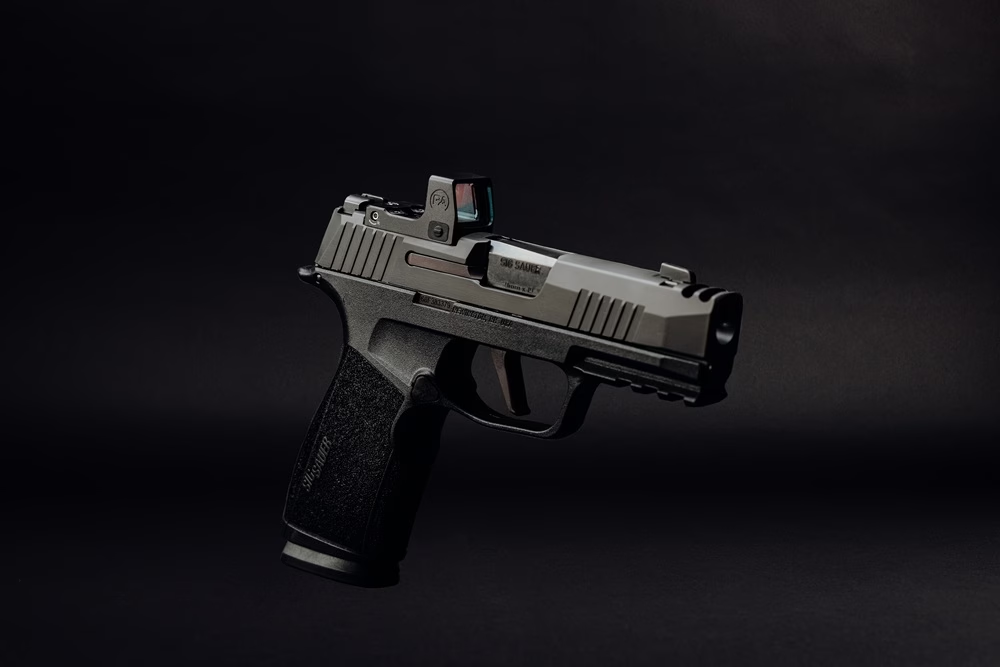
Classic Series 21mm Mini Reflex Sight Gen 2
The Primary Arms Classic 21mm Micro Reflex Sight Gen 2 is one of the most affordable mini-reflex sights available for micro-compact and other slim pistols like the GLOCK 43x/48, SIG Sauer P365, and the Springfield Armory Hellcat, for example. Don’t let its small size dissuade you from considering it over other compact reflex sights, these reflex sights are remarkably compact and lightweight. Weighing only .56 ounces, it hardly changes the maneuverability and handling of your pistol, and with its 21x15mm lens, you’ll still be able to quickly acquire your reticle and target with ease.
They make use of a durable 6061 aluminum housing, have 10 different brightness settings and a battery life that lasts upwards of 40,000 hours, making them a more-than-viable pick for use as a dedicated concealed carry optic. And, this optic comes with AutoLive® Motion-Activation as well as an automatic shut-off feature, so you won’t have to worry about turning your optic off after use. Lastly, depending on your preference, the Primary Arms Classic Series 21mm Micro Reflex Sight is available two configurations that project a red and green 3-MOA dot, respectively.

Classic Series 24mm Mini Reflex Sight Gen 2
Designed for use on larger/standard sized pistols, the Primary Arms Classic Series 24mm MRS Gen 2 is an excellent budget optic. Much like its little brother mentioned above, it features a resilient 6061 aluminum optic body and weighs just under an ounce—0.98 ounces to be exact. Overall, this optic has many of the same features as the 21mm MRS, but it has some key differences since it’s a larger optic.
Obviously, being a larger optic, it has a bigger 24x17mm window, making it easy to find the dot under pressure. It also compatible with the popular Trijicon RMR mounting footprint, making it compatible with many of the industry’s popular handguns. Like the 21mm MRS, it comes equipped with PAO’s AutoLive motion-sensing illumination and automatic shut-off feature, and it’s powered by a CR2032 battery, giving it a battery life of around 40,000 hours. And depending on your preference, they’re available with either a red or green 3-MOA dot reticle too.
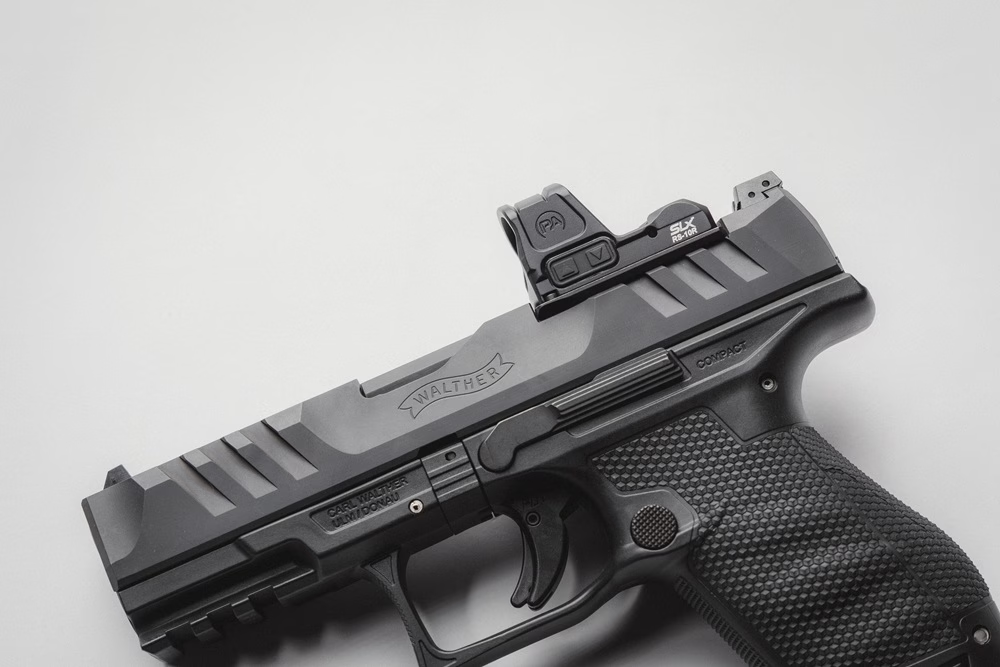
SLx RS-10R: The Workhorse Reflex Sight
A step up in quality and price, the Primary Arms SLx RS-10R Mini Reflex Sight is designed for full-size pistols, and is packed with a plethora of impressive features, as well as multiple refinements over the prior RS-10 design.
For starters, the RS-10R is exceptionally durable—using a 7075-T6 aluminum construction, it offers an extra degree of durability over the Classic Series optics, making it a better choice for use in rougher conditions. Additionally, the battery is inserted via a tray on the side of the optic, meaning you don’t need to remove and re-zero the optic when you need to change your battery. And, though it takes CR1632 batteries instead of CR2032s, the RS-10R is still outfitted with AutoLive and an auto shut-off, giving it a long lifespan of 40,000 hours.
The RS-10R mounts to pistols using the Trijicon RMR mounting footprint, making it compatible with many popular pistols, but rather than shipping with just the optic itself, it also comes with a dedicated picatinny rail mount for use on smaller carbines and PCCs. Overall, its 3-MOA dot reticle makes it a great pick for both pistols and compact rifles, holding its own against other optics in its class.

GLx RS-15: ACSS Innovation Meets Premium Design
Also, a part of PAO’s RS line of optics, the GLx RS-15 is one of the more premium mini reflex sights offered by PAO. Optics in the GLx line are renowned for their higher overall quality, with the RS-15 being a prime example of this. An excellent mid-tier optic, the RS-15 is more-than-suitable for just about every application as its durable 7075 aluminum construction is both waterproof and shockproof, giving it an edge against harsher conditions. Plus, its higher quality glass and improved lens coatings allow for some of the best clarity possible.
However, this isn’t the RS-15’s biggest upgrade. This optic makes use of the ACSS® Vulcan® reticle system. If you haven’t already read about the Vulcan in our earlier articles, it’s easily one of the most advanced pistol reticle systems available. The Vulcan is made up of a 3-MOA center dot and a 250-MOA outer circle. Unlike standard circle dot reticles that always have the circle visible when aiming properly, the Vulcan’s outer circle is only visible when your aim is off-center. This gives the RS-15 a unique advantage, allowing you to quickly find the dot when under stress or in dynamic applications.
While certainly useful, having the ACSS Vulcan means the RS-15 has a shorter battery life compared to the other optics mentioned thus far. When using the Vulcan reticle, the RS-15’s battery life lasts around 5,000 hours, and while this sounds like a rather brief period of time, this is still over half a year of constant runtime. Plus, if you’d prefer, you can switch off the Vulcan’s outer circle, leaving just the 3-MOA dot—in this mode, the RS-15’s battery life can last upwards of 25,000+ hours. And once you factor in AutoLive, it’s a long-lasting reflex sight that’s perfect for everything from recreational shooting to competitive and duty use.
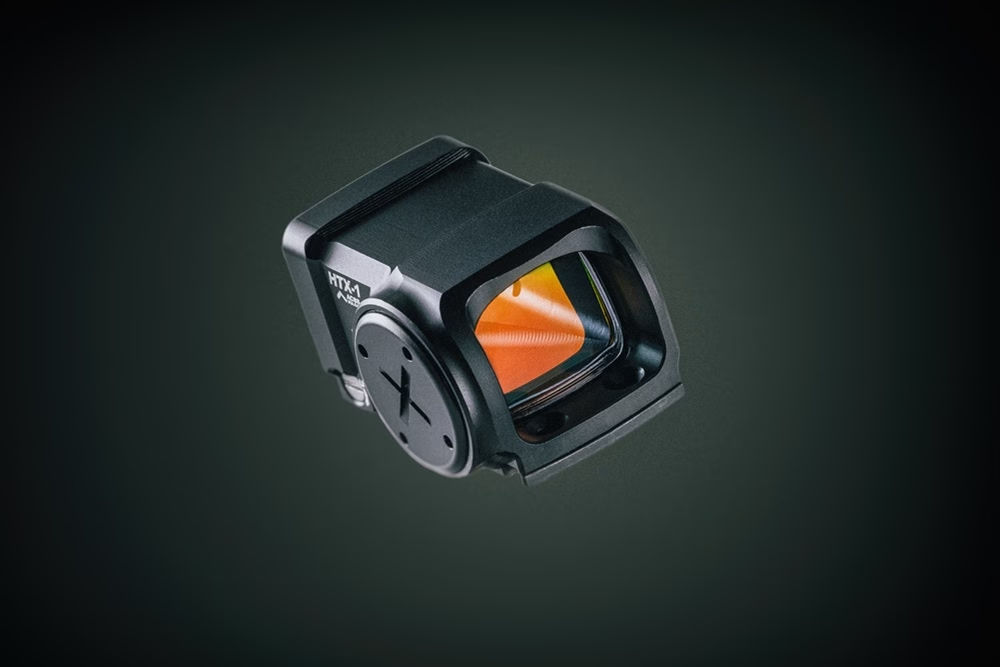
PLx HTX-1™: The Professional’s Choice
One of the newest additions to PAO’s lineup is the PLx HTX-1, their first enclosed pistol red dot sight option, and their first American made optic. Being a part of their PLx line of optics, the Primary Arms HTX-1 is engineered to offer nothing short of top-tier performance across all scenarios and applications. Being an enclosed optic, it boasts an incredible degree of durability, and it’s also available with the ACSS Vulcan reticle (or a single 4-MOA dot if you prefer) making it perfect for everything from EDC use and recreational shooting to more intensive competitive and duty use.
Like the last two optics mentioned thus far, the HTX-1 uses a rugged 7075-T6 aluminum construction that’s waterproof and shockproof too. And, with it being enclosed, you won’t need to worry about the emitter diode becoming occluded from any environmental hazards like dirt or mud. But, while this optic is certainly tough, one of its most enticing features is its mounting system.
The HTX-1 is compatible with nearly every currently existing pistol optic mounting footprint. See, rather than mounting directly to the pistol’s slide, the HTX-1 mounts to its own patented chassis system. Included with the optic are a series of chassis mounts that are compatible with different mounting footprints. Once mounted to the slide, the optic can be mounted to the chassis, giving it a naturally low deck height that can even co-witness with standard height iron sights too.
Conclusion
The introduction of pistol reflex sights has absolutely changed the optic game for pistols, pushing the limits of what handguns are capable of. Compared to stock iron sights, reflex sights outclass them in just about every regard, making them some of the best upgrades you can make to your pistol—and if you’re looking to add one to yours, PAO has you covered on all fronts.
From budget-friendly, minimalistic optics that still come packed to the brim with top-tier features, to duty-grade optics ready to meet and exceed the demands of professional use, PAO truly has something for everyone. And now that you know what’s behind the glass, you can peruse their offerings with confidence, equipped with the knowledge needed to find the best mini-reflex sight for your setup.
